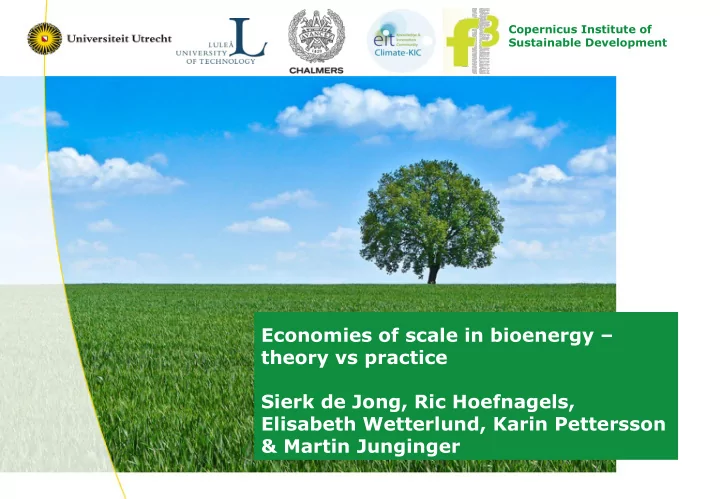

Copernicus Institute of Sustainable Development Economies of scale in bioenergy – theory vs practice Sierk de Jong, Ric Hoefnagels, Elisabeth Wetterlund, Karin Pettersson & Martin Junginger Copernicus Institute of Sustainable Development
In the oil industry bigger is usually cheaper, in biofuel it is more complex Oil industry Production costs ( € /GJ) Production scale Biofuel Production costs ( € /GJ) ? Production scale Copernicus Institute of Sustainable Development
A stylized example of the biofuel supply chain Our biofuel supply Theoretical scale curve* chain Production cost ( € /GJ biofuel) 1 Transport 𝑢𝑑 𝑤 2 ∝ 𝛾𝑌 2 , 𝑥ℎ𝑓𝑠𝑓 𝛾 ∝ 1 𝜍 CAPEX ∝ 𝛽𝑌 𝑡𝑔−1 , 𝑥ℎ𝑓𝑠𝑓 𝛽 ∝ 𝐽 𝑑𝑝𝑜𝑡𝑢𝑏𝑜𝑢 𝑥𝑗𝑢ℎ 𝑌 OPEX 𝑑𝑝𝑜𝑡𝑢𝑏𝑜𝑢 𝑥𝑗𝑢ℎ 𝑌 Feedstock Production scale X *Where X is scale, tc v the variable transport cost, sf the scaling factor and I the investment Copernicus Institute of Sustainable Development
The optimal capacity 𝒀 depends on technological scalability and capital intensity, feedstock density and transport cost 1 𝛾 𝑡𝑔−1.5 = 𝑌 2𝛽 1 − 𝑡𝑔 Increasing transport cost Decreasing scaling factor Decreasing feedstock density Increasing capital intensity Example Pyrolysis tc v = 0.1 € /tkm I = 350 M € @ 400MW Sf = 0.7 ρ = 30 t/km 2 /yr ~ 7 Mt/yr 𝐘 𝒀 𝒀 𝒀 Copernicus Institute of Sustainable Development
However, in practice there are more parameters which affect the theoretical scale curve Maximum capacity In practice, material limitations, shipping limits, site size and frame size may curb the size of (parts of) a conversion plant Maximum capacity Production cost ( € /GJ biofuel) Theoretical scale curve Scale X Copernicus Institute of Sustainable Development
Distributed supply chain configurations can aid to limit the impact of growing transportation cost Centralized supply Distributed supply chain chain Legend Feedstock Pre-conversion unit Conversion unit Storage terminal Lower CAPEX, higher Higher CAPEX, lower transportation cost transportation cost Copernicus Institute of Sustainable Development
However, in practice there are more parameters which affect the theoretical scale curve Maximum capacity In practice, material limitations, shipping limits, site size and frame size may curb the size of (parts of) a conversion plant Additional factors affecting Maximum capacity the scaling curve in practice, e.g. Production cost ( € /GJ biofuel) Maximum capacity • Supply chain configurations • Inhomogeneous feedstock • density Inhomogeneous feedstock • price Theoretical scale curve Competing demand • Transport infrastructure • Transport modes • Integration with host • industries Distributed supply chain configuration Scale X Copernicus Institute of Sustainable Development
We used an optimization model to develop a scale curve for biofuel production in Sweden Techno-economic data CAPEX (dependent on scale & site) • OPEX (dependent on site) • Feedstock HTL* Hydro- Blending Constraint on maximum capacity • processing terminal *Hydrothermal liquefaction Feedstock supply & prices Spatially explicit for Sweden • Forestry residues • Stumps • Byproducts from • Sawlogs saw- and pulpmills • Pulpwood Linear optimization Competing feedstock demand model Optimizing system** cost for a given biofuel demand District heating Pulp and paper Sawmills **System = Biofuel & Conversion sites competing industry • Forest terminals • Refineries • Pulpmills • LNG terminals • Sawmills • Natural gas pipeline • District heating connection Transport modes • Truck • Train • Short sea Copernicus Institute of Sustainable Development
The model can choose between centralized and distributed supply chain configurations at different locations Centralized supply Distributed supply chain chain Legend Feedstock HTL Hydroprocessing Storage terminal Potential HTL locations: Pulp mill, Potential locations: Refineries, sawmill, district heating, forest natural gas grid connection, LNG terminals terminal Potential upgrading locations: Refineries, natural gas grid connection, LNG terminal Copernicus Institute of Sustainable Development
At a plant level economies of scale and the maximum capacity determine the shape of the scaling curve Observations 1. Jigsaw curve due to maximum capacity 2. Downward trend beyond maximum plant capacity 25 3. Distributed over centralized supply chains at small capacities 24 Production cost ( € /GJ biofuel) 23 22 21 20 19 Distributed : high 18 CAPEX, low upstream transport cost Centralized : low 17 CAPEX, high upstream transport cost 16 15 0 5 10 15 20 Plant scale (PJ) Preliminary results, please do not cite Copernicus Institute of Sustainable Development
On a system level the cost curve has an upward tail which is caused by increasing feedstock prices, not by transport cost Observations 1. Convex total cost curve 2. Interplay between conversion cost 25 and feedstock cost; relatively constant upstream transport cost 3. Preference for distributed Production cost ( € /GJ biofuel) configurations at higher scales 20 Total 15 Feedstock Upstream transport Conversion and upgrading 10 Intermediate transport Downstream transport 5 0 0 50 100 150 200 One upgrading More upgrading Total biofuel production (PJ) plant plants Preliminary results, please do not cite Copernicus Institute of Sustainable Development
Preliminary conclusions Economies of scale and maximum achievable capacity are the most Key important determinants in the biofuel scaling curve, not transportation determinants costs (unlike theory) for scaling Distributed supply chain configurations are favored over centralized Distributed vs. ones at small scale due to integration benefits and preferential siting centralized (unlike theory) From a system’s perspective distributed supply chain configurations are System’s favored, as there are limited locations at which centralized production perspective makes sense (combination of high feedstock density and required utilities) Copernicus Institute of Sustainable Development
Thank you for your attention! Sierk de Jong Utrecht University Supported by s.a.dejong@uu.nl Copernicus Institute of Sustainable Development
Recommend
More recommend